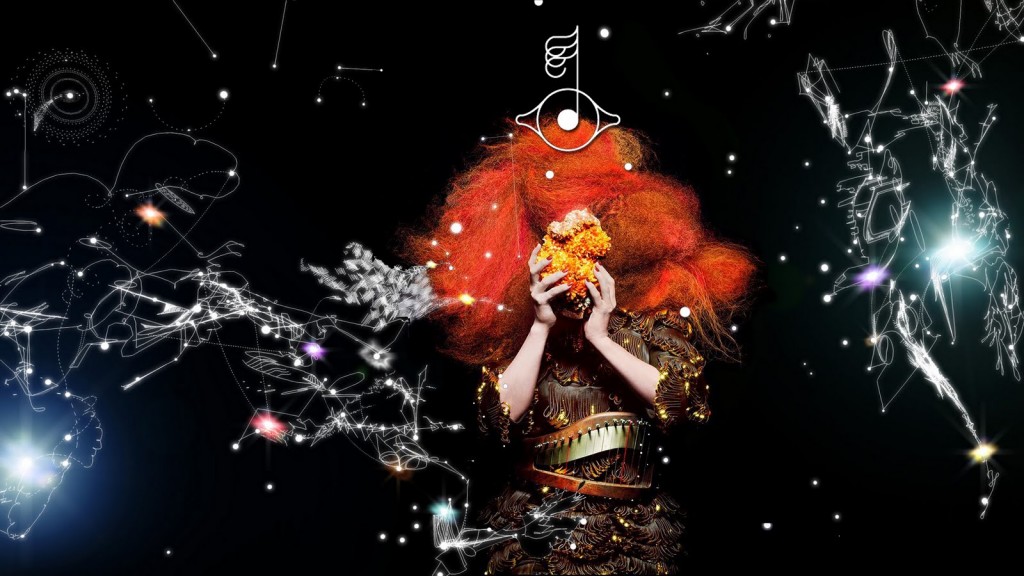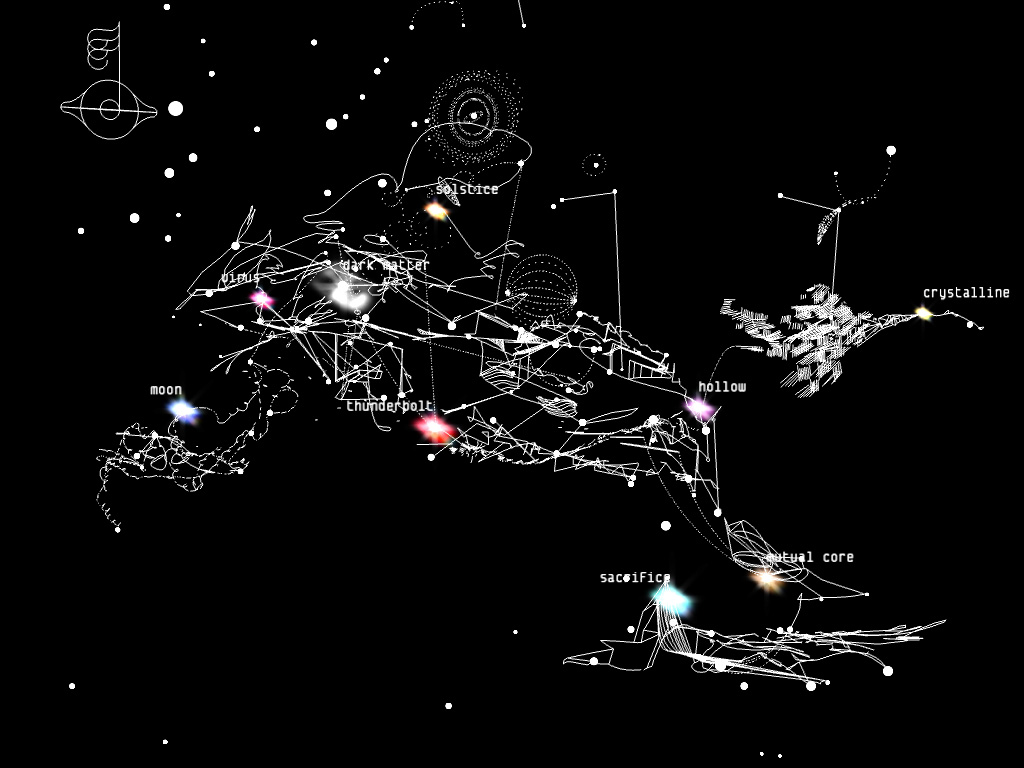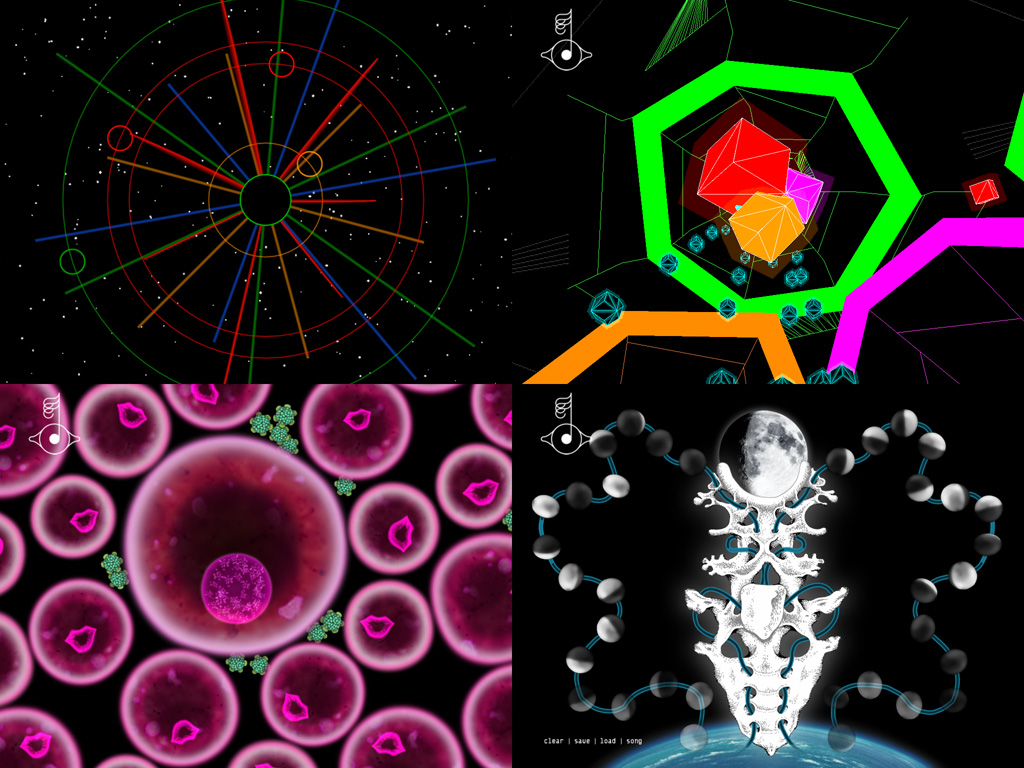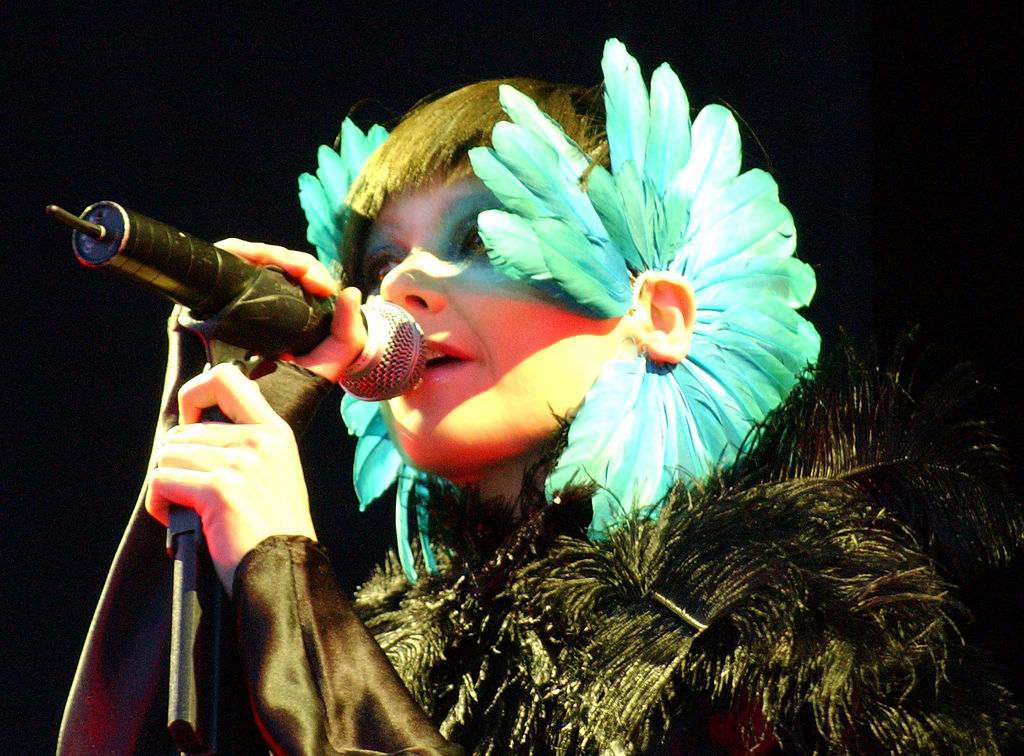
Björk - a very bright star.
avant-garde
noun \ˌä-ˌvän(t)-ˈgärd, ˌa-; ə-ˈvänt-ˌ; ˌa-ˌvōⁿ-ˈ, ˌa-ˌvȯn(t)-ˈ\
1. an intelligentsia that develops new or experimental concepts especially in the arts
French, vanguard
First Known Use: 1910
“Avant-garde in music can refer to any form of music working within traditional structures while seeking to breach boundaries in some manner, or to describe the work of any musicians who radically depart from tradition altogether.” *1
It is within this conceptual realm that Björk has thrived for more than three decades; ever evolving sonically and prolifically spinning artistic wonder. And she has just done it again.
Start Here
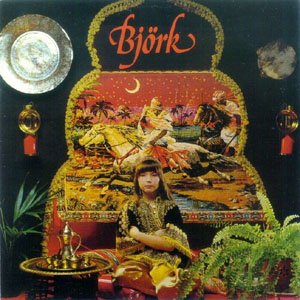
Björk's first album. Her mom created the album's Arabian Nights / Icelandic genie look. It's awesomely Royal Tenenbaums-ish.
Icelandic singer Björk first emerged from music school in 1976 at the age of 11, with her cover of Tina Charles’s I Love to Love rotating in on Reykjavik’s RUV. Well received, Björk was given the opportunity to record an album. Simply entitled “Björk”, an album consisting of various pop radio covers and one original piece was recorded and locally released in 1977. Her stepfather produced the album and Björk’s mother, Hildur Hauksdóttir, designed the album’s artwork.
Following her first album, Björk was offered the chance to do a second album, but she turned it down. With the money earned, Björk purchased a piano and started composing new songs of her own. Since that time, Björk has repeated this reinvestment formula again and again; pooling all of her resources to pursue her own vision of music and maintaining her sense of self.
Fast Forward
Emerging internationally with the Sugarcubes and the song Birthday in the late eighties, Björk has become one of the world’s most successful and highly-regarded recording artists. In the nineties, Björk anchored her legacy with the help of Nellee Hooper (the Bristol producer / remixer / composer for several seminal 90s albums including Massive Attack’s Protection) and created two albums that defined the period, Debut and Post.
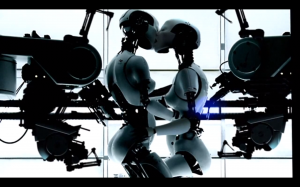
In 1999, Bjork, director Chris Cunningham and Glassworks London forever digitized Bjork and the intimacy of machines with their All is Full of Love video. The video won two MTV Video Music Awards for Breakthrough Video and Best Special Effects and is considered to be one of the best videos of all time. The video is on permanent exhibition at the Museum of Modern Art in New York.
Digital Creative for Digital Creatives
Albums such as Debut, Post, as well 1997’s Homogenic, allowed Björk to collaborate with many of that decade’s great visual designers, including Michael Gondry [Human Behavior and Bachelorette], Stéphane Sednaoui [Possibly Maybe], Paul White [Hunter], Spike Jonez [It’s Oh So Quiet], Chris Cunningham [see left] and more. As time progressed, it became understood that Björk’s dedication to artistic collaboration in music and mixed media was second to none.
Music and its applied video arts typically steer cultural trends. These trends trickle down from an artist’s experimental video work, through fan / follower production designers & directors to film, television and advertising (especially in the 1990s, which was notably packed with nascent and emergent digital technologies). With this mass propagation, our overall cultural experience and consciousness moves forward. And with nearly 51 nominations and 15 awards in various international music, video (television) and film awards under her belt, it’s safe to say that Björk’s ever evolving art has had a massive cultural impact.
The Art of Creating Music >> Shifted
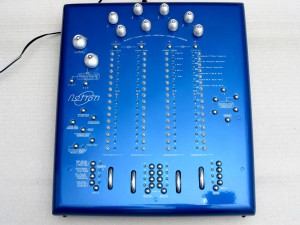
Latronic's Notron sequencer. Bjork and Mark Bell produced unique sounds on Homogenic using a Notron to control a 909 and various synths. Only approx. a hundred of these British-made devices were manufactured.
“Following the minimal electronic music of Brian Eno and the krautrock band Tangerine Dream, 1990s electronic dance music was influenced by changes in technology that lead to the use of production methods based on repetition, especially the genres of trance, minimal techno and ambient. Well-known artists include The Orb, Orbital, Underworld and Aphex Twin.” *2
Björk and her various producers (Mark Bell, Howie B, etc.) have been crafting their work with portable and non-traditional music production tools for years. During the 1990s, much industry research and development was invested in professional audio creation and recording instruments, such as keyboards, midi controllers, drum machines, samplers, sequencers and non-linear music production programs. Björk and her producers, like many great 90s music artists, gravitated to these newer experimental platforms – the 90s are brimming with great albums that utilized new programming techniques. Björk’s creative use of these new technologies (and her spectacular voice) are hallmarked by her 1997 album, Homogenic; an album that is considered to be a creative zenith for Björk, and, “if not the greatest electronic album of all time, it’s certainly the greatest of its decade.” *3
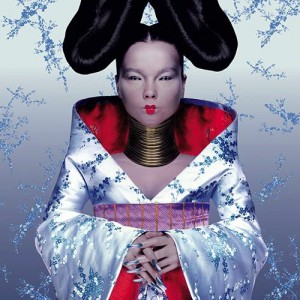
Homogenic, 1997. Bjork's cover art has graduated to design work by Alexander McQueen.
The Art of Experiencing Music >> Shifted
Since launching in 2001, Apple’s iTunes (and Apple’s subsequent mobile device iOS) has taken the digital space by storm – integrating phones, tablets, peripherals, music and a massive bank of portable applications. This dominance has created both opportunity and disruption across all forms of lifestyle media and other near-alike technologies. It is worth noting that many people, certainly from Generation X and prior, miss the physical discovery and listener experience associated with the purchase of actual CDs or albums. Albums and their accompanying liner notes & studio art round out the listeners immersion in the artist’s theory and cognitive function. With the rise of iTunes and the demise of corner record stores, this quickly became a romance under served.
Simultaneously, recognizing the importance of portability and accessibility for musicians, music device companies developed and migrated digital versions of their instruments (limited and full flavors) and other specialist software to the iPad platform. This process created several new opportunities for new and older artists: #1 – Pro music tools are no longer cost prohibitive to new musicians (as with their more hardware-based progenitors) #2 – The user experience of these programs has been greatly optimized and simplified for tablets and touch screens (think hit pads vs. string strumming) #3 – Upon download and boot-up, the musician experience is immediate and so is the production quality. #4 – The entire music suite has become hyper-portable.
Today, Björk experiments and composes her music utilizing iPad apps and similar touchscreen experiences. It appears it was only a matter of time before Björk explored the app frontier; to find out what it would ultimately mean for her music. And true to her nature, she cracked things open like a small sea-island earthquake – opening up a tiny fault line and kicking up newness that demands exploration.
#pause#
Biophilia >> Björk’s Game Changing Project
In late 2011, Björk released her latest musical project titled Biophilia. Excluding Bjork’s soundtrack work, Biophilia represents her eighth full-length studio album. It arrives over four years after her last studio album and stands apart from prior works; assembled with equal parts of performance and installation artwork. Multiple (and entirely new) instruments were handcrafted to complement her compositions, including a Gameleste, a high-voltage Tesla Coil Bass/Synth and a gravity-driven Pendulum Harp; each a beautiful and deserved work of art that appears predestined to fold into either the Tate Modern or the MOMA.
With Biophilia Björk wished to reconnect listeners to her more tectonic sonic creations; an album similar to Homogenic in spirit, but a fault-line further travelled and much more primordial. Integrate voice, wind, water, rock, electricity and computer processor. The album’s tracks, its cosmos of custom-crafted instruments and its three-dimensional galaxy of song applications were created as auditory and interactive gateways to a deeper atomic layer of the natural universe. The world Björk has created feels part Alice in Wonderland, part 18th century Industrial Revolution and part Frank Herbert’s Dune. Sir David Attenborough even lends his voice from the naturalist mentor ether.
Biophilia’s music and applications ask users to recalibrate and apply a new level of thoughtfulness to the significance of music and sound… to explore the relationships between musical structures and natural phenomena. From the atomic to the cosmic, the approach is hypnotic. Her apps re-engage people with the process-of and immersion-in symbiotic music and progressive rock. With the rise of iTunes, the decline of tangible physical media and the rise lightweight (heavily marketed) pop icons, it appears that Björk is working to re-anchor the art of music composition, immersion and interaction.
The artist / album app is poised to replace the cardboard covers and inserts that for many years provided the context and story of an album. Now, music app owners can buy into a much richer and dynamic artist / album experience – across multiple platforms. For the artists themselves, (if done right) this direct access could generate more revenue and overall artistic control than they have enjoyed before. Artist / director / creator / album apps stand to reboot recording creativity after the nearly disastrous turbulence that the rise of digital media files forced upon artists in the 2000’s. Digital content delivery and consumption is maturing.
To create the cosmos that is Biophilia, Björk created a virtual science guild – collaborating with Scott Snibbe, the designers at M/M (Paris), as well as approx. thirty other artists, instrument makers, writers and software developers. The album’s mothership app is essentially Free, with add-on song-game apps ($1.99 each or $9.99 for everything) that allow users to interact with the physical forces, processes and structures behind each song. As mentioned earlier, Björk creates her music using a variety of tools, but it appears her musicality remains piano based – seeking harmonic, melodic and resonance interplay with strong hammer percussion sensibilities. This style expresses itself in the global feel of the Biophilia application, as well as the user experiences of the individual song-game apps.
Why Do I Like This?
Most of the articles that I’ve read that cover the release of Biophilia focus on the fact that the app is cool and wonderful and very Björk. This is clearly true. However, there is something greater in action – and I like the direction that Björk has taken.
The internet is transforming. The document web (web pages and their files) as we know it is waning. Its users chased off by poor design, a general lack of innovation, security concerns, unwelcome interactions and, in general, too many marketing & web tracking tendrils intertwined with the web’s original protocols. It’s for these and other reasons that people have jumped to closed systems such as Facebook, but Facebook too has increasingly opened its environment to marketers – and proved too often that safeguarding user privacy is not a priority. Soon we will leave there, too.
With these changes in mind and with new mobile connected devices, people are flocking to portable applications which take users directly to favored experiences and media. As I mentioned earlier in Digital Nomads – Part II, beginning in 2011, more than half of all mobile internet traffic was video related. Connected applications and their necessary operating environments are spreading across all major electronics devices. For example, among the many items on display at this year’s 2012 Consumer Electronic Show, smart televisions continued to play a highly competitive game. Each manufacturer essentially adopting and/or optimizing computer-like internals and operating systems to support internet connections, applications and digital media interaction. Touch and gesture control will soon follow these innovations. Instead of turning channels, we will be moving through unique applications and digital media by hand on smart glass. (Apple has even rebooted their intent to enter the TV market.)
I like what Björk has accomplished with Biophilia. The whole of the project is much greater than the sum of its music, new instruments and games. The music is more cerebral – and it’s fantastic. See Crystalline performed here. Björk has not only created her first application, she’s essentially taken the first step in creating a dedicated interactive content channel – one that directly connects fans with her music, videos, instruments, games, et al. In the near future, you may be able to open, play and interact with Björk’s entire creative library on a wall-mounted touchscreen television (or tablet) – completely transforming how you (and your family) experience her content and ideas.
Biophilia was no small undertaking and it was certainly not cheap. The experience is high-concept – its interactivity even surrounding fans when Biophilia is performed live. The work aspirational – illustrating why Björk is considered a true artist and why she remains one of the world’s greatest cultural assets.
Thank you Björk, for once again summoning your resources and driving innovation. We really do enjoy it.
// Christopher Jones
PS – There is a Biophilia multimedia immersion series currently taking place at the New York Hall of Science in Queens, New York. Go here for more info. If you live in the area, you may want to participate.
*1 – Avant-garde Movement
*2 – Minimal Music
*3 – BBC Music
*4 – Slant Magazine

